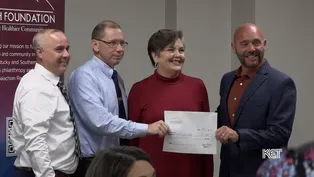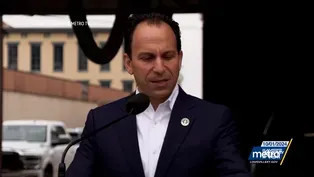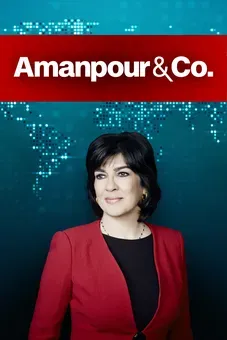
LG&E and KU Energy Discusses Restoration Efforts
Clip: Season 3 Episode 88 | 7m 52sVideo has Closed Captions
LG&E and KU Energy's Liz Pratt talks about how the companies are working to restore power.
Kentucky Utilities serves more than one million customers across the state. Five days after Hurricane Helene slammed into the Florida coast, 1% of KU's customers are still in the dark. Renee Shaw talks with communications director Liz Pratt about how the company is working to restore power.
Problems playing video? | Closed Captioning Feedback
Problems playing video? | Closed Captioning Feedback
Kentucky Edition is a local public television program presented by KET

LG&E and KU Energy Discusses Restoration Efforts
Clip: Season 3 Episode 88 | 7m 52sVideo has Closed Captions
Kentucky Utilities serves more than one million customers across the state. Five days after Hurricane Helene slammed into the Florida coast, 1% of KU's customers are still in the dark. Renee Shaw talks with communications director Liz Pratt about how the company is working to restore power.
Problems playing video? | Closed Captioning Feedback
How to Watch Kentucky Edition
Kentucky Edition is available to stream on pbs.org and the free PBS App, available on iPhone, Apple TV, Android TV, Android smartphones, Amazon Fire TV, Amazon Fire Tablet, Roku, Samsung Smart TV, and Vizio.
Providing Support for PBS.org
Learn Moreabout PBS online sponsorshipKentucky Utilities serves more than 1 million customers across the state five days after killing 1% of their customer base is still in the dark.
Renee Shaw talked with Liz Pratt, who is a communications director for LG and E and Q Energy about how they're working to restore power.
Renee Well, thank you, Laura, and thank you, Liz, for a few minutes of your time.
We appreciate you driving in from Louisville to talk with us about this important issue and about the power that's being restored.
First, let people know what is the coverage area of Q LG and how many customers, businesses, residences are served.
Yes.
So between LG and Q, we serve about 1.3 million customers and our customers are spread out across more than 90 counties here in Kentucky.
And we have some customers down into Virginia.
MM So tell us about the power outages that are related to this latest storm, Helene, and how that restoration process is going.
Since since really Helene started moving in through our service areas on September 27th, in totality, we had more than 220,000 customers affected by this storm.
So through that time, crews have been responding to about 1600 reports of wires down more than 160 broken poles.
And in addition to our crews and business partners working in the field, we brought in additional support.
So in total, we had more than a thousand individuals, line technicians and support personnel through our business partners and even our our sister utility in Pennsylvania.
People, you coming in to support our customers to get power restored.
And currently to date, we're more than 99% customers restored of customers who were impacted by the storm.
So is there a particular region or area of the state that that 1% is residing that still waiting to have their power back on?
You know, at this point, there were areas that were hit harder.
You know, Lexington in particular had some of the strongest wind gusts.
So from Lexington and Richmond and Maysville, those were some of our hardest hit areas, also down into Pine Ville.
But really, the outages occurred across our service area.
And so what crews have been doing for the last several days is what we refer to as the heavy lifting.
This is repairing those broken poles and damaged equipment and restoring those lines that are down.
And so in those hardest hit areas, there are some more complicated areas where the crews need to get in.
So it takes more time for some of those complicated locations.
So crews have been working everywhere from along mountainsides to in tight spaces in back yards, requiring specialized equipment to busy city streets.
And so through all of this, safety is always our top priority.
When do you think the 1% will be joining the other 99%?
Any idea?
We will continue working with our customers.
There may be some cases where, as crews enter an area during that assessment process, they may identify that at the at the customer's property that there's damage that may require an electrician.
So there may be so we work with our customers throughout the restoration process to identify if there may be damages that the customer's property.
That is a safety concern that before we can restore their service, they may need to have an electrician make repairs so that we we can safely restore that power.
When a lot of us media folks look at those power outage maps.
And I want you to clarify, because not every power outage that may be we even see if we look at that map now is related to the healing storm.
Right.
That there could be other things that have happened that don't give a full picture of how it's being condensed or prescribed to a particular weather related incident.
Can you explain.
That?
That's a really great point.
So based upon, you know, being able to track our customer outages during a storm event, we will track those customers who have been impacted.
So oftentimes that's why you might see those numbers are fluctuating and those numbers continue to climb.
So as crews assessed locations, as customers were reporting their outages, that's where we really saw those numbers climbing.
And so that's why in total, we now know that more than 220,000 customers were affected by the remnants of Hurricane Helene.
Mm hmm.
So let's talk about the consumer questions, we'll call it.
Right, because we know that there are some people just taking the Lexington area, for example, who were without power for two or three days, maybe four.
And people wonder what's taking so long?
What's your response?
Sure.
So I'll I'll start first by kind of explaining a little bit about our prioritization process.
So leading up to a storm, we're monitoring the forecast.
We are mobilizing our crews and our resources across more than 40 crew centers that we have across our service territories.
In addition, we're coordinating with utility partners.
So that's leading up to a storm coming into our service area.
So as that storm system continues to move through, first our focus is public safety, protecting the public.
So as reports of downed wires are coming in, we want to we are responding to emergency situations, protecting those downed wires and really addressing public protection.
And so as we're doing that, we're also then moving in to restoring power for critical community services that may be hospitals or police and fire departments.
And so we'll look at our at our at those critical community services and then we'll move into how can we restore power to as many customers as we can.
And so as we move through that prioritization process, we start getting down into the repairs.
And that is what I refer to as the heavy lifting.
That's where it is.
Crews manually getting to a location to replace a pole, to restrain downed wires, move debris, to be able to access our equipment.
So that takes time as crews are entering areas and especially in these hardest hit areas where they are manually moving through by each outage.
So in the remnants of Hurricane Helene in particular, our crews were responding to more than 2800 events.
And an event is an outage location that's affecting customers.
So as you think about crews moving through our service area, as we're able to restore power in areas, then we also start moving our crews.
So I mentioned our crew centers.
That gives us that ability to move our crews to help move to areas that are still affected.
And so as we're bringing in partners, as we're moving our crews, that process and that coordination is taking place in real time to get power restored to our affected customers.
And then as we're moving through the repair process, we're then getting into individual outages that might be at a customer's home or business, or it might be only a couple customers on that particular outage.
So we move through that prioritization process to restore power safely and as quickly as possible for all of our affected customers.
Renee, we'll have more with Liz Pratt tomorrow about how the energy company is keeping up with technology when it comes to delivering power.
ARH Donates to EKY School Districts
Video has Closed Captions
Clip: S3 Ep88 | 3m 6s | ARH donated $70,000 to seven Eastern Kentucky school districts impacted by the 2022 floods. (3m 6s)
Video has Closed Captions
Clip: S3 Ep88 | 4m 2s | Bluegrass Youth Ballet recently debuted a new dance created by the founder of the program. (4m 2s)
Kentucky Helping States Recover From Helene
Video has Closed Captions
Clip: S3 Ep88 | 1m 42s | The Kentucky Air National Guard is being deployed to North Carolina. (1m 42s)
Louisville Reintroducing Mask Ordinance
Video has Closed Captions
Clip: S3 Ep88 | 1m 12s | Louisville's mayor says the city will soon begin enforcing a decades-old ordinance regarding masks. (1m 12s)
Providing Support for PBS.org
Learn Moreabout PBS online sponsorshipSupport for PBS provided by:
Kentucky Edition is a local public television program presented by KET















